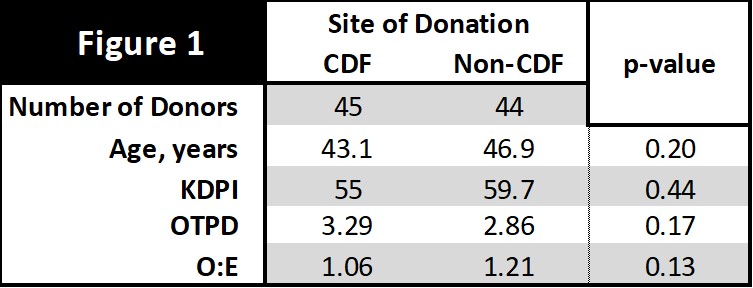Organ Donation at a Centralized Donation Facility Compared to Donation at Referral Hospitals
1Organ Recovery, LifeShare Transplant Donor Services of Oklahoma, Oklahoma City, OK, 2LifeShare Transplant Donor Services of Oklahoma, Oklahoma City, OK
Meeting: 2022 American Transplant Congress
Abstract number: 1786
Keywords: Donation, Economics, Outcome, Procurement
Topic: Clinical Science » Organ Inclusive » 68 - Deceased Donor Management and Intervention Research
Session Information
Session Name: Deceased Donor Management and Intervention Research
Session Type: Poster Abstract
Date: Tuesday, June 7, 2022
Session Time: 7:00pm-8:00pm
 Presentation Time: 7:00pm-8:00pm
Presentation Time: 7:00pm-8:00pm
Location: Hynes Halls C & D
*Purpose: An emerging model of donor management includes utilization of a Specialized Donor Care Facility (SDCF) – essentially a stand-alone OPO-based procurement facility in which brain-dead donors are transferred for donor management and recovery. These facilities have been reported to save money and improve organ yield; however, they are costly to build and maintain. We present our experience with a Centralized Donation Facility (CDF).
*Methods: In 2018, a Request for Proposal for a CDF was sent to multiple large hospitals in our DSA. Ultimately, we partnered with a local non-transplant center hospital. Our contract includes case rates, ICU bed availability, diagnostic testing, and OR availability. Our study includes donors performed at the CDF and compared them to non-CDF facilities from January 2020 to June 2021. Non-CDF transplant center hospitals were excluded from the analysis since they perform organ donation on site for cost reporting purposes. Observed-to-expected (O:E) organ placement rates were calculated. Financial data was obtained by reviewing individual hospital billing. Incomplete billing figures were imputed with the average of per-case billing from the same hospital.
*Results: Of all eligible donors, 50.6% were transferred to the CDF. Although the OTPD was 15% higher in the CDF, this did not reach statistical significance (Figure 1). Further, CDF costs were 15% higher than non-CDF costs (data not shown, p=0.02), primarily due to costs of critical care transport between the two hospitals. Donors transferred to the CDF tended to be younger, and have a lower KDPI, and yielded a lower O:E than non-CDF donors, although none of these metrics reached statistical significance.
*Conclusions: Overall, we are pleased with the performance of our CDF. Opportunities for improving case rates and patient transport costs were discovered. Unintended benefits, such as decreased coordinator and surgeon travel, as well as the advantage of working with a consistent team at the CDF also resulted. A constant presence of our OPO’s personnel at the CDF donor hospital was noted to have a positive impact throughout several departments at the CDF, including an increase in donors originating at the CDF institution. Establishment of a CDF is an effective way to improve organ yield without the high capital expense of building a SDCF. Additionally, since our OPO has a donor population that is greater than 40% DCD, opportunities may exist for transfer of DCD donors to the CDF.
To cite this abstract in AMA style:
Hawxby AM, Ketcham R, Leader JE, Burch D, Benoit M, Squires RA, Hostetler C, Orlowski JP. Organ Donation at a Centralized Donation Facility Compared to Donation at Referral Hospitals [abstract]. Am J Transplant. 2022; 22 (suppl 3). https://atcmeetingabstracts.com/abstract/organ-donation-at-a-centralized-donation-facility-compared-to-donation-at-referral-hospitals/. Accessed December 30, 2025.« Back to 2022 American Transplant Congress

